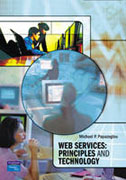
Web services, usually including some combination of programming and data, aremade available from a business's web server for web users and other web connected programs. The accelerating creation and availability of these services isa major computing trend as software becomes increasingly distributed and web-based. Web services are the next logical step for web-based computing and willhave a profound impact on the way in which business is conducted on the web in the future. As they involve many different systems communicating with each other, they are particularly important following the proliferation in the rangeof computing devices (PDA's mobile telephones, hand held computers etc). Thisbook will provide a comprehensive treatment of the concepts and isses in web services, looking at how they are designed, and the key technologies, and standards used. INDICE: PART 1 BASICS Chapter 1. Web Services basics 1.1. Introduction 1.2. The Concept of Software as a Service 1.3. A More Complete Definition of Web Services 1.4. Characteristics of Web Services 1.5. Service Interface and Implementation 1.6. The Service Oriented Architecture (SOA) 1.7. The Web Services Technology Stack 1.8. Quality of Service 1.9. Web Services Interoperability 1.10. Web Services versus Components 1.11. Impact and Shortcomings of Web Services 1.12. Summary PART 2 ENABLING INFRASTRUCTURE Chapter 2. Distributed Computing Infrastructure 2.1. Distributed Computing and Internet Protocols 2.2. The Client/Server Model 2.3. Characteristics of Inter-Process Communication 2.4. Synchronous Forms of Middleware 2.5. Asynchronous Forms of Middleware 2.6. Request/Reply Messaging 2.7. Message Oriented Middleware 2.8. Transaction Oriented Middleware 2.9. EnterpriseApplication and e-Business Integration 2.10. Summary Chapter 3. Brief Overview of XML 3.1. XML Document Structure 3.2. URIs and XMLNamespaces 3.3. Defining Structure in XML Documents 3.4. XML Schema Reuse 3.5. Document Navigation and Transformation 3.6. Summary PART 3 CORE FUNCTIONALITY AND STANDARDS Chapter 4. SOAP: Simple Object Access Protocol 4.1. Inter-Application Communication and Wire Protocols 4.2. SOAP as a Messaging Protocol 4.3. Structure of a SOAP Message 4.4. The SOAP Communication Model 4.5. Error Handling in SOAP 4.6. SOAP over HTTP 4.7. Advantages and Disadvantages of SOAP 4.8. Summary Chapter 5. Describing Web Services 5.1. Why is a Service Description Needed? 5.2. WSDL: Web services Description Language. 5.3. Using WSDL to Generate Client Stubs 5.4. Non-functional Descriptions in WSDL 5.5. Summary Chapter 6. Registering and Discovering Web Services 6.1. Service Registries 6.2. Service Discovery 6.3. UDDI: Universal Description, Discovery, and Integration. 6.4. Summary PART 4: EVENT NOTIFICATION AND SERVICE ORIENTED ARCHITECTURES Chapter 7. Addressing and Notification 7.1. Web Services and Stateful Resources 7.2. Introduction to the WS-Resource Framework 7.3. Web Services Notification 7.4. Web Services Eventing 7.5. Summary Chapter 8. Service-Oriented Architectures 8.1. What is a Software Architecture 8.2. The Service Oriented ArchitectureRevisited. 8.3. Service Roles in an SOA 8.4. Reliable Messaging 8.5. The Enterprise Service Bus 8.6. The Extended Service Oriented Architecture 8.7. Summary PART 5: SERVICE COMPOSITION AND SERVICE TRANSACTIONS Chapter 9. Processes and Workflows 9.1. Business Processes and their Management 9.2. Workflows 9.3. Business Process Integration and Management 9.4. Cross-enterprise Business Processes 9.5. Service Composition Meta-model 9.6. Web Services Orchestration and Choreography 9.7. The Business Process Execution Language (BPEL) 9.8. Choreography 9.9. Other Initiatives and Languages 9.10. Summary Chapter 10. Transaction Processing 10.1. What is a Transaction? 10.2. Distributed Transactions 10.3.Nested Transactions 10.4. Transactional Web Services 10.5. WS-Coordination and WS-Transaction 10.6. Web Service Composite Application Framework 10.7. Summary PART 6: SERVICE SECURITY AND POLICIES Chapter 11. Securing Web Services 11.1. Web Services Security Considerations 11.2. Network Level Security Mechanisms 11.3. Application Level Security Mechanisms 11.4. Security Topologies 11.5. XML Security Standards 11.6. Securing Web Services 11.7. Summary Chapter 12. Service Policies and Agreements 12.1. What are Policies and why are they Needed? 12.2. Types of Policies 12.3. Policies and Web Services Standards 12.4. WS-Policy Framework 12.5. Service Agreements 12.6. Summary PART 7: SERVICE SEMANTICS AND BUSINESS PROTOCOLS Chapter 13. Semantics and Web Services 13.1. The semantic Interoperability Problem 13.2. The Role of Metadata 13.3. Resource Description Framework 13.4. Richer Schema Languages 13.5. WS-Metadata Exchange 13.6. Summary Chapter 14. Business Protocols 14.1. The Supply Chain Business EcoSystem 14.2. Semantic Problems at the Business Process-Level 14.3. Business Standards and Protocols 14.4. XML in Vertical Organizations 14.5. Summary. PART 8:SERVICE DESIGN AND DEVELOPMENT Chapter 15. Web Services Development Lifecycle15.1. Why is a Web Services Development Methodology Needed? 15.2. Web Services Development and Related Methodologies 15.3. System Development Life Cycle 15.4. Properties of Service-Oriented Design and Development 15.5. Service-Oriented Design and Development Milestones 15.6. Qualitiy of Service-Oriented Designand Development. 15.7. Overview of Web Services Development Life Cycle 15.8 The Planning Phase 15.9 The Analysis Phase 15.10. The Service Design Phase 15.11. The Service Construction Phase 15.12 The Service Test Phase 15.13 The Service Provisioning Phase 15.14 The Service Deployment Phase 15.15 The Service Execution Phase 15.16 The Service Monitoring Phase 15.17 Summary PART 9: SERVICE MANAGEMENT Chapter 16. Web Services Management 16.1. Managing Distributed Systems 16.2. Enterprise Management Frameworks 16.3. Conceptual Management Architecture 16.4. Standard Distributed Management Frameworks 16.5. Web Services Management 16.6. The Web Services Distributed Management Initiative 16.7. Summary PART 10: EMERGING TRENDS Chapter 17. Recent Trends and Developments 17.1. GridComputing 17.2. Mobile Computing 17.3. Summary. References. Index.
- ISBN: 978-0-321-15555-9
- Editorial: Pearson Education
- Encuadernacion: Rústica
- Páginas: 752
- Fecha Publicación: 11/10/2008
- Nº Volúmenes: 1
- Idioma: Inglés
